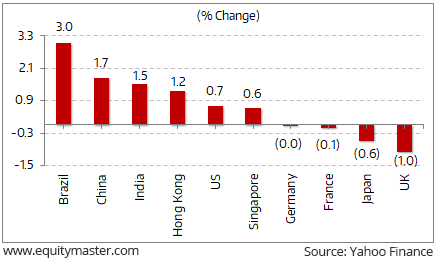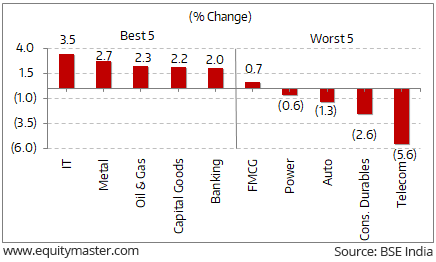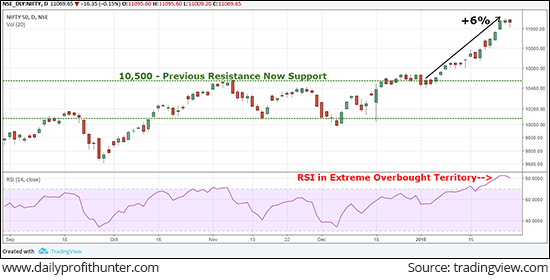Global Financial Markets Continue To Rally
Global stock markets rose on the final trading day, recouping losses from earlier in the week, as the dollar steadied against other currencies.
Major indexes in the US hit session highs, finishing the day squarely in record territory and booking a fourth straight weekly advance. A reading of fourth-quarter gross domestic product came in slightly softer than expected but was viewed by Wall Street as healthy enough not to derail the perception that the economy is on firm footing.
President Donald Trump delivered a keynote speech at the World Economic Forum in Davos, Switzerland highlighting the strength of the domestic economy and offered a less protectionist stance on international trade.
The European markets ended Friday's session with modest gains. The markets climbed in early trade, but settled into a sideways pattern for the bulk of the session. France's CAC 40 was up 0.87% while London's FTSE 100 was up 0.65% and Germany's DAX was up 0.31%.
Stock markets in Asia were mixed with benchmark indices in Hong Kong and China surging by 1.6% and 0.3% respectively, while the index in Japan ended the week lower by 0.2%.
Key World Markets During the Week

Back home, benchmark indices in India logged marginal gains of 0.3%, as a spurt in pharma stocks propelled the BSE Sensex to close the year above 34,000 levels.
BSE Indices During the Week

Now let us discuss some key economic and industry developments of last week.
The government unveiled the first tranche of the massive 2.11 trillion bank recapitalization plan. The government will infuse a total of Rs 881 billion into 20 public sector banks which account for more than 80% of the colossal R s8.4 trillion worth of bad loans.
The money will go to all public sector banks but one - Indian Bank.
11 lenders under the Reserve Bank of India's Prompt Corrective Action will together receive Rs 523 billion or the lion's share of the total amount. These are banks that cannot even meet the regulatory minimum in capital.
Public Sector banks (PSB) had a field day on 24th October 2017 after the government's announcement of the recapitalisation plan. Under the plan, it is set to inject Rs 2.11 trillion into public sector banks over a period of two years. State-run bank stocks went up from 30% to 49% in a day.
The government's move was mainly aimed at resolving the long standing non-performing assets (NPA) problem of PSBs. It is expected to shore up the capital of state-run banks, spurring them to clean up the bad loan mess and revive lending.
In news from the economy, highlighting India is coming out of post Goods and Services Tax (GST) implementation woes, global rating agency, Standard & Poor's (S&P) ratings, in its latest report titled 'APAC Economic Snapshots, January 2018' has said that overall economic risks in India remain low, on the back of pick up in industrial output and bank credit.
However, the rating agency raised concerns over rising crude oil prices, terming it as a 'risk' for the country, as a majority of India's import bill stem from crude oil purchases.
The report further mentioned about recent growth of industrial sector, noting that Industrial output (and investment more generally) -- the missing piece of the sustainable growth story in recent years -- jumped to a 25-month high in November, led by manufacturing. Besides, the rating agency also highlighted improving bank credit situation to the real economy.y
In the news from currency markets, the rupee edged up 5 paise to 63.82 against the US dollar today. This was seen on the back of increased selling of the dollar by exporters and banks.
Note that the rupee surged almost 6% against the dollar in 2017, mostly driven by strong inflows into capital markets.
The appreciation in the rupee comes as a welcome breather for importers in India. A softer rupee helps importers to buy goods and services at a cheaper rate that earlier. This is vital for a developing economy that relies heavily on imports. So this bodes well for the Indian economy as higher imports normally mean increased economic activity.
But on the other hand, the rise in rupee can spell trouble for exporters. The exporters are at a disadvantage owing to the currency appreciation as this renders their produce expensive in the international markets as compared to other competing nations whose currencies haven't appreciated on a similar scale. This tends to take away a part of the advantage from Indian companies, which they enjoy due to their cost competitiveness.
Nonetheless, a stronger rupee will pull down commodity prices and help in keeping a tab on rising inflation.
While there are advantages as well as disadvantages of a rising rupee, one needs to understand whether the rise in the rupee is sustainable to derive any reasonable conclusion at this stage.
For one, the weakness of the US dollar is largely due to the relative unattractiveness of US assets. This is in part due to a very low interest rate regime prevalent in the US economy. Already there are indications that this low interest rate regime may not be sustainable for long. This means that US interest rates may go up and this may likely strengthen the US dollar.
It would be interesting to see how the above trend pans out in 2018. We'll keep you updated on the developments.
Moving on to the news from the economy. As per the International Monetary Fund (IMF), India is expected to grow at 7.4% of its gross domestic product (GDP) in 2018 as against China's 6.8%. This will make India the fastest growing economy among emerging economies following last year's slowdown due to demonetization and the implementation of goods and services tax (GST).
In its latest World, Economic Outlook update released on Monday ahead of the World Economic Forum in Davos, the IMF projected India's GDP growth rate at 7.4% in 2018 and 7.8% in 2019.
China, during the same period, is expected to grow at 6.8% and 6.4% respectively.
The aggregate growth forecast for emerging markets and developing economies for 2018 and 2019 remain unchanged, with marked differences in the outlook across regions.
In 2017, China's GDP growth rate of 6.8% was ahead of India's at 6.7%, giving the former the tag of being the fastest growing emerging economy. The Indian economy, which grew at 7.1% in 2016, slowed in 2017 due to demonetization in November 2016 and GST rollout on July 1, 2017.
As for the US, whatever output impact its tax cut will have on an economy so close to full employment will be paid back partially later in the form of lower growth, as temporary spending incentives (notably for investment) expire and as increasing federal debt takes a toll over time, the reports noted.
Moving on to the news from steel sector. In order to boost the steel sector, the steel ministry has sought waiver of the import duty on coking coal.
Ahead of the Union Budget 2018-19, the steel ministry in its recommendations to the finance ministry has suggested bringing down the import duty on coking coal to 0% from 2.5%.
Further, the ministry also suggested bringing down the import duty on steel scrap to nil. India has to heavily depend on import of coking coal, as the domestic quality has higher ash content, which is unsuitable for the steel industry with present technology.
To bring down the imports of coking coal, the steel ministry had earlier said that it was in discussion with the coal ministry for investment in washeries.
According to the Coal Minister Piyush Goyal, during April-September of the ongoing fiscal, 22.6 million tonne (MT) (provisional) of coking coal was imported. He added that while 41.6 MT coking coal was imported in 2015-16, the import was 43.5 MT.
Meanwhile, India's annual steel production crossed 100 million tonne (MT) mark last year. The country's total steel production in the year 2016 was around 95 MT.
Between January 1, 2017 and December 31, 2017, the country crossed 100 MT-mark and produced 101 MT steel.
Movers and Shakers During the Week
| Top Gainers During the Week (BSE Group A) | ||||
|---|---|---|---|---|
| Company | 19-Jan-18 | 25-Jan-18 | Change | 52-wk High/Low |
| JUBILANT FOODWORKS | 1,892.35 | 2,210.00 | 16.8% | 2,330/818 |
| BIOCON LTD | 551.00 | 606.40 | 10.1% | 658/295 |
| MPHASIS Ltd | 759.50 | 827.00 | 8.9% | 854/522 |
| TCS | 2,889.45 | 3,122.00 | 8.0% | 3,255/2,154 |
| TECH MAHINDRA | 553.30 | 597.35 | 8.0% | 615/358 |
| Top Losers During the Week (BSE A Group) | ||||
| LANCO INFRATECH | 2.23 | 1.69 | -24.2% | 5/`1 |
| VIDEOCON INDUSTRIES | 23.40 | 19.10 | -18.4% | 110/12 |
| BHUSHAN STEEL | 69.20 | 59.90 | -13.4% | 103/51 |
| RELIANCE COMMUNICATIONS | 32.40 | 28.35 | -12.5% | 42/10 |
| GITANJALI GEMS LTD | 75.35 | 66.10 | -12.3% | 105/53 |
Source: Equitymaster
Key corporate developments of last week
Moving on to the news from the energy stocks. HPCL may acquire Mangalore Refinery and Petrochemicals Ltd (MRPL) in a cash and share- swap deal to become India's third-largest oil refiner.
One shall note that, Oil and Natural Gas Corp (ONGC) last week announced acquisition of HPCL for Rs 369.15 billion. After this takeover, ONGC has two refining subsidiaries - HPCL and MRPL.
Reportedly, HPCL (Hindustan Petroleum Corp Ltd) sells more petroleum product than it produces and bringing MRPL's 15 million tonne a year refinery under the fold would help bridge the shortfall.
Further, ONGC plans to maintain HPCL as an independent listed company under whom all its downstream units can be consolidated.
While ONGC holds 71.6% stake in MRPL, HPCL has 17%.
After ONGC completed acquisition of the government's 51.11% shares, HPCL will become a subsidiary. The transaction allows the government to monetise its HPCL ownership without losing ultimate control of the company.
HPCL will add 23.8 million tonne of annual oil refining capacity to ONGC's portfolio. This together with 15 million tonne refinery of MRPL will create India's second-biggest state-owned oil refiner after Indian Oil Corp (IOC).
Overall, it will become the third biggest refiner behind IOC and Reliance Industries. MRPL will be the third refinery of HPCL, which already has units at Mumbai and Visakhapatnam.
Meanwhile, Oil & Natural Gas Corporation will use a mix of debt, cash reserves and proceeds from a planned sale of stakes in IndianOil and GAIL to fund its acquisition of HPCL.
ONGC needs to pay Rs 369 billion for the government's 51.11% stake in HPCL by January-end. The deal would make state-run ONGC the third largest refiner in India, after Indian Oil and Reliance Industries, and give it control over nearly a fourth of filling stations.
ONGC's 13.77% stake in IndianOil and 4.86% in GAIL can fetch about Rs 300 billion at current market prices. In addition, ONGC has about Rs 500 billion of sanctioned loans at favourable terms
For funding the deal, the company's order of priority is cash reserve, sale of stakes in IndianOil and GAIL, followed by debt, according to news reports.
ONGC has entered into short-term loan agreements with three banks to partly fund its acquisition of HPCL.
Accordingly, the company has entered into agreements with Punjab National Bank, Axis Bank and Bank of India on January 22 for loans totaling to Rs 180.6 billion. The agreements are for short-term loans to part-finance the acquisition of HPCL.
Reportedly, PNB will lend Rs 106 billion, while the loan amount from BOI will be Rs 44.6 billion and that from Axis Bank will be Rs 30 billion.
Further, the company is likely to sign-up more loan agreements to pay for acquiring government's 51.11% stake in HPCL for Rs 369.2 billion. ONGC is to pay the government for the stake within this month, the reports noted.
Notably, the acquisition would create India's first integrated oil company. This would be ONGC's biggest acquisition and second buyout this fiscal after its Rs 77.4 billion acquisition of 80% stake in Gujarat State Petroleum Corp's KG basin gas block.
As per ONGC, the company's board has approved raising of the borrowing limit from Rs 250 billion to Rs 350 billion.
This will be the company's first ever debt.
One should note the company announced on on January 20 a buy of government's 51.11% stake in HPCL for Rs 473.97 per share in an all-cash deal that is to be closed before the month-end.
So, what lies ahead for the merged entity? Richa Agarwal, our oil & gas sector analyst has shared her views in the recent edition of The 5 Minute WrapUp. Here's a snippet of what she wrote:
"A fall in the oil prices has dented the profitability of oil exploration companies such as ONGC. The merger with a downstream company will help ONGC de-risk its business. ONGC will also benefit from the huge fuel retail network of HPCL."
Going forward, whether the move will be executed well or will lead to further complexities and integration issues instead of synergies will be the key thing to watch out for.
As per an article in The Economic Times, Japanese steelmaker JFE Holdings, and Sajjan Jindal's JSW Steel, are likely to put in a joint bid for bankrupt Bhushan Steel.
As per the reports, even Tatas and Arcelor Mittal may also seek to buy the company to benefit from an upswing in an industry overcoming four years of supply overhang.
Bhushan Steel faces Rs 558.68 billion in claims from financial creditors. Of this, the resolution professional has accepted only Rs 444.98 billion by way of claims. It also faces claims of Rs 14.36 billion from operational creditors.
Bhushan Steel is among the 12 entities for which RBI directed banks to refer the company to the bankruptcy court immediately.
Steel stocks finished the day on a weak note with Jindal Saw Ltd share price and Tayo Rolls share price leading the losses.
And here's an update from our friends at Daily Profit Hunter.
This week, the Indian stock markets ended its January futures and options (F&O) expiry. Let's have a look at how the Nifty 50 Index performed during the expiry.
It was remarkable expiry for the Indian indices. Except for the initial two days, the bears did not stand a chance. The Nifty rallied one way from the low of 10,405 to cross another landmark figure of 11,000. It tough a life-time high of 11,110 in the last week of the expiry. The index finally ended the January series with a solid 5.65% gains.
Last expiry, we mentioned that the index has broken above its important resistance level of 10,500. This indicated strength in the price action. Our derivative and rollover analysis in Profit Hunter Pro newsletter (subscription required) also suggested positive outlook for the Indian market in the January expiry. As a result, the index rallied nearly 6% to touch a life-time high of 11,110.
But the index rally in the January expiry was quite steep. The RSI indicator is also in its overbought territory. So can we expect a correction in the February expiry or will the index keep going up?
The derivative and rollover data can give us some clue about this.
Nifty 50 Index Ends January Expiry 6% Up

Disclaimer: Equitymaster Agora Research Private Limited (hereinafter referred as 'Equitymaster') is an independent equity research Company. Equitymaster is not an Investment Adviser. ...
more


